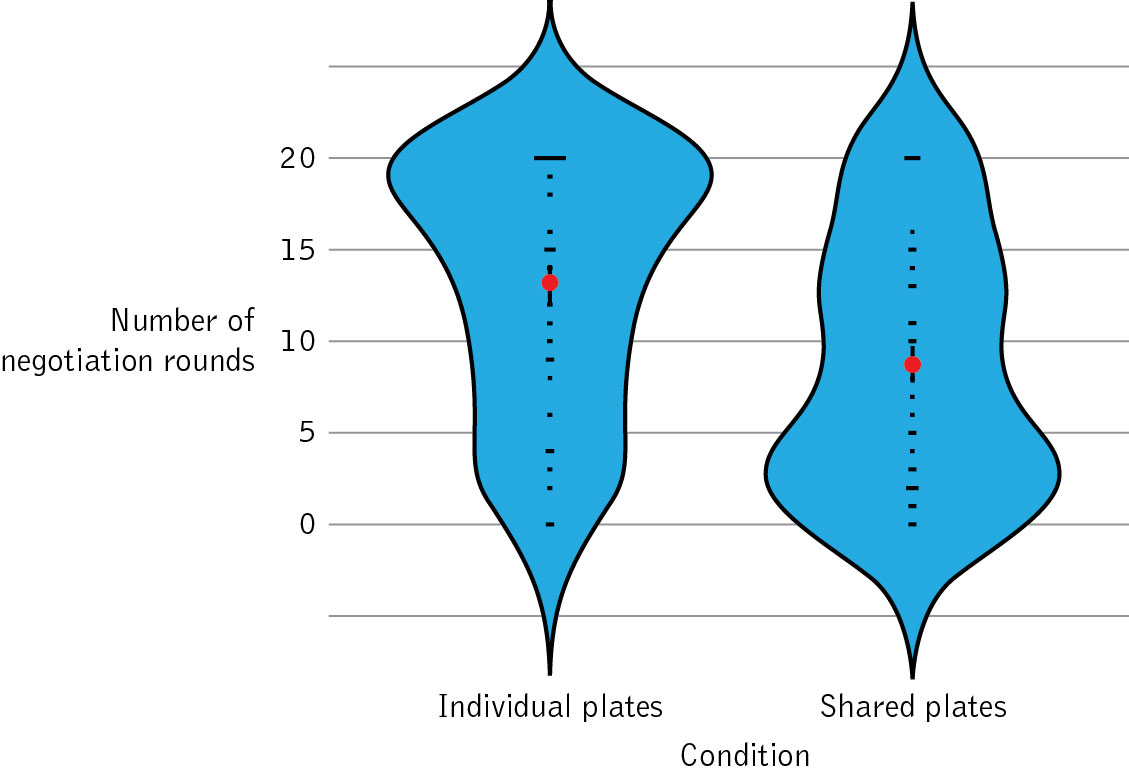Chapter
1. Central Tendency and Variability: Are You Going to Eat That?
1.1 Central Tendency and Variability: Are You Going to Eat That?
CENTRAL TENDENCY AND VARIABILITY: ARE YOU GOING TO EAT THAT?
Are You Going to Eat That?
true
true
true
You must read each slide, and complete any questions on the slide, in sequence.
Welcome
Are You Going to Eat That?
Kelly M. Goedert, Seton Hall University
Susan A. Nolan, Seton Hall University
Kaylise D. Algrim, Seton Hall University
In many cultures, serving food “family style” is the norm when a large group of people share a meal together at home. Large dishes are brought to the table and people can take what they wish. Think of how different this situation is from what frequently occurs in restaurants—where individuals each receive separate plates with a certain portion size. When we serve ourselves from a shared dish, we have to take into account our dining companions as we decide how much to take for ourselves. Could sharing food this way make us more cooperative generally, even in other contexts?

Jasmin Merdan/Getty Images
Question
1.1
Consider your own experience.
1.2
Researchers Kaitlin Woolley and Ayelet Fishbach (2019) told participants that they were participating in a study on the effects of hunger. Pairs of participants were told to eat a snack of salsa and chips with a stranger, after which they engaged in a negotiation task. After which, they engaged in a negotiation task. Half of the participant-pairs were randomly assigned to share a plate of chips and salsa, and the other half of participant-pairs were randomly assigned to eat their own individual servings. More specifically, the researchers reported that “participants were run in pairs of strangers. We preregistered the study and collected data from 200 undergraduate and graduate students outside a campus café (107 female; age: M = 23.57 years, SD = 8.80)” (p. 542).
Question
1.2
Gh8B+0WuS4IKG0ETRguFXsgEAkoMH741Mx1o6O1MP7hFQqYWYCC5te5A9UXbvBR1IGkigHTnmpqEGxkeTIyMtM9+ccX+k9qN+3kwtG28MVExjgk4CtqpCybGv54ZLs//mo/QQHBExpi2xl4Fmh5fLKUMO+jEhXthTj23NMDspxHlaRzRkJ1ry1K+cEg/A4fYjiuwDFp2wk4VKmeJW8Ew/BuO3kY2BOo9QmVk630qGDjqB7GKlN+g4aCwF++lewGcu4h5OBO5hraquSy17JqafOJ3qiJpnfqyA/yWgZZwK98iD7IAmXKud2ad44uWjpkNFFIjVE5dy8d8mErzq6gk115CZzsa0JyGqXuvCDZt/jq7DyHTz+bYmOtdEJcnS43sHv6V+PGUwr5RWirQ2YjJYth1cs+upjkqEt9keNz1fQzwUbTDcDobzF3vTJmx4cwGEMoiKHC+ZZXn7H+Nt0yryZixek/NQ5zvZpmsYGpExXEWjL93bBh3zazKqJknaIhNCbH7VxrsV2Ihew/cAZglLWPnpNeDinOI9UaNqV0Q5PVFWT2IFb5Ycly8sei9u1CiMKiGgKDg2iJgchMXPavWb6sIHwTJkd7WaFPFzqoaWJ0toxr6rNZ4hzNGhDnaC+o7jHuEyEQBfvwhyvLofnUdeF66oiNUGWD9wG3vk1SFQT8/K+pvytrjuOpRJDcEXGcFyrnPjA==
Correct! The researchers recorded their research design and analysis plan before conducting the study, so that they could not engage in the sketchy behavior of changing their methods and analyses later on.
Actually, the researchers recorded their research design and analysis plan before conducting the study, so that they could not engage in the sketchy behavior of changing their methods and analyses later on.
1.3
As we noted previously, the researchers reported that “participants were run in pairs of strangers. We preregistered the study and collected data from 200 undergraduate and graduate students outside a campus café (107 female; age: M = 23.57 years, SD = 8.80)” (p. 542).
Question
1.3
QlPO06bji9cFVi5wikh4poaVr5c2BAvsV3wWURnYOj2No6VeVLYDplkzXbNUPEn0LbomxPYICzFsBqyWnOB3ps0w2uVgcbpr/j1rRXmCZChLRhcE0KoyyzkvhOlYwqQQQ553sL7oM75ZyX4X9AqiubJSmSUcz4mDB/u31/xd6GgJD6wgAv3GR4PDZfBcIaVEelQwY9ooIACtMR41XnYQ4VL6rgF6Rd2EViewbEsU7Fs4ciEggzdFCn7Uq6C32eajlqMnN1ZcVnmLySpPp+SBS0sf0yKy8jYcjVvEf+7l5G6rNVKD/6Kpg1vH0Wto+40g6Br6KO83/h+ZFWDDD/zgVM5227qsyF9ohlS9BI7ocDkLlHKQqljeTMqNjrmNHa8V5h3qW9NuXPGqwlBo2VwxT/bc3Z/8j+vmGma9uBNILOKxYwzj3H4kwZEx1gU6r15+OT5pP0PAGzMGYJpdHIY/gv43N3ylW/xu7FtkjYNoeH9Yr9H8tRzCft5Rj8HnuU161qywUQeOP5ZDF1UzYucnabnEr3XtpX/bfq5Jft02GcBhlmZrk18W8yjjNUFesi2GPkG7Bxh8VoLEaqhsayBJIIDO2PgHNtDozwa1PKXeF69poREVhVw6ay7YHuYB6Xorcsm1B2o2H4aL7bnZmdreR9AeB7as/XmrGG/4tOTBoF6YagL49g4YUg==
Correct! M is the symbol for mean, and SD is the symbol for standard deviation. So, the mean age is 23.57 and the standard deviation is 8.80.
Actually, M is the symbol for mean, and SD is the symbol for standard deviation. So, the mean age is 23.57 and the standard deviation is 8.80.
1.4
As we noted previously, the researchers reported that “participants were run in pairs of strangers. We preregistered the study and collected data from 200 undergraduate and graduate students outside a campus café (107 female; age: M = 23.57 years, SD = 8.80)” (p. 542).
Question
1.4
The researchers note that 107 of the 200 participants were female.
Correct! “Female” is the modal gender for participants. With nominal data, only the mode makes sense to use.
Actually, “female” is the modal gender for participants. With nominal data, only the mode makes sense to use.
1.5
Question
1.5
After eating their chips and salsa—either from a shared plate or from two individual plates—each pair of strangers engaged in a negotiation that involved determining the hourly wage for union workers at a company. One participant represented the union and the other represented management. The dependent variable was the number of rounds of negotiation until the two sides came to an agreement. The scores ranged up to 20 rounds, at which point the participants were no longer allowed to keep negotiating.
Correct! Twenty rounds is a ceiling effect. It’s not possible to have a score higher than 20 rounds, so there may be a ceiling effect.
Actually, 20 rounds is a ceiling effect. It’s not possible to have a score higher than 20 rounds, so there may be a ceiling effect.
1.6
In Chapter 3, we introduced the violin plot. In their results, the researchers included this pair of violin plots.

image description
Two violin plots (graphs shaped a little like violins but with points on the top and bottom) are shown, one for each of the two conditions (individual plates on the left and shared plates on the right). The label to the left of the two violin plots reads, “Number of negotiation rounds” and there are light horizontal lines running through the violin plots from “0” to “20” at intervals of 5, although both violin plots go both higher and lower than these data points. Both violin plots are outlined in black, red in with blue, and have about one dozen data points each, represented by small dots arranged vertically in the middle of each plot. Each violin plot also has a red dot, lined up with the small dots, representing the mean, 13.20 for the individual plates condition on the left and 8.72 for the shared plates condition on the right. For the violin plot on the left, the outline, which represents the distribution, peaks at around 20 and tapers down beyond 0. For the violin plot on the right, the outline peaks between 0 and 5 and tapers as it goes beyond 20.
Question
1.6
The red dots in the middle of each violin plot represent the means of the two distributions.
Correct! The red dot that indicates the mean for those who ate from individual plates is higher than that for those who ate from shared plates. This indicates that pairs of participants took longer, on average, to reach an agreement when they did not share chips and salsa. If this holds up under hypothesis testing, we would have evidence that sharing food leads to cooperation in other contexts.
Actually, the red dot that indicates the mean for those who ate from individual plates is higher than that for those who ate from shared plates. This indicates that pairs of participants took longer, on average, to reach an agreement when they did not share chips and salsa. If this holds up under hypothesis testing, we would have evidence that sharing food leads to cooperation in other contexts.
1.7

image description
Two violin plots (graphs shaped a little like violins but with points on the top and bottom) are shown, one for each of the two conditions (individual plates on the left and shared plates on the right). The label to the left of the two violin plots reads, “Number of negotiation rounds” and there are light horizontal lines running through the violin plots from “0” to “20” at intervals of 5, although both violin plots go both higher and lower than these data points. Both violin plots are outlined in black, colored in with blue, and have about one dozen data points each, represented by small dots arranged vertically in the middle of each plot. Each violin plot also has a red dot, lined up with the small dots, representing the mean, 13.20 for the individual plates condition on the left and 8.72 for the shared plates condition on the right. For the violin plot on the left, the outline, which represents the distribution, peaks at around 20 and tapers down beyond 0. For the violin plot on the right, the outline peaks between 0 and 5 and tapers as it goes beyond 20.
Question
1.7
Violin plots also tell us a lot about variability and the shape of distributions.
Correct! The violin plot represents the individual data points, some of which fall at 0 and some of which fall at 20. So, the range is from 0 to 20.
Actually, the violin plot represents the individual data points, some of which fall at 0 and some of which fall at 20. So, the range is from 0 to 20.
1.8

image description
Two violin plots (graphs shaped a little like violins but with points on the top and bottom) are shown, one for each of the two conditions (individual plates on the left and shared plates on the right). The label to the left of the two violin plots reads, “Number of negotiation rounds” and there are light horizontal lines running through the violin plots from “0” to “20” at intervals of 5, although both violin plots go both higher and lower than these data points. Both violin plots are outlined in black, colored in with blue, and have about one dozen data points each, represented by small dots arranged vertically in the middle of each plot. Each violin plot also has a red dot, lined up with the small dots, representing the mean, 13.20 for the individual plates condition on the left and 8.72 for the shared plates condition on the right. For the violin plot on the left, the outline, which represents the distribution, peaks at around 20 and tapers down beyond 0. For the violin plot on the right, the outline peaks between 0 and 5 and tapers as it goes beyond 20.
Question
1.8
Violin plots also provide information about variability and the shape of distributions. The outline of these plots gives us a sense of the distribution in terms of where more scores in the samples fall.
Correct! The data from the individual-plate condition seem to be somewhat negatively skewed; there’s a higher concentration of scores on the upper end, with the tail trailing off toward 0. The data from the shared-plate condition seem to be somewhat positively skewed; there’s a higher concentration of scores on the lower end, with the tail trailing off toward 20.
Actually, the data from the individual-plate condition seem to be somewhat negatively skewed; there’s a higher concentration of scores on the upper end, with the tail trailing off toward 0. The data from the shared-plate condition seem to be somewhat positively skewed; there’s a higher concentration of scores on the lower end, with the tail trailing off toward 20.
1.9
The bottom line: Cooperating over a meal does seem to lead to cooperation in other situations. Our suggestion? The next time you want your friends to agree with you, take them out for a shared meal before you make your proposal!

-/AFP/Getty Images




